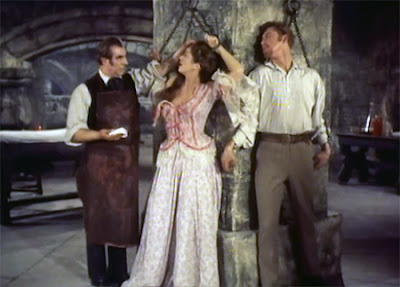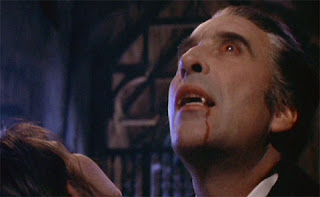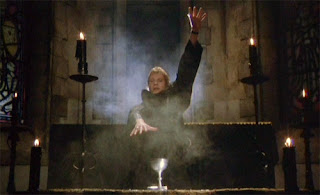Now Playing: Blood of the Vampire (1958)
Pros: Plenty of Gothic atmosphere; helped reboot Gothic horror in the late ‘50s.
Cons: Lacks action and chills; the villain is more of a dumpy burgomeister-type than a horrifying menace
Pros: Plenty of Gothic atmosphere; helped reboot Gothic horror in the late ‘50s.
Cons: Lacks action and chills; the villain is more of a dumpy burgomeister-type than a horrifying menace
I finally did it -- I canceled Netflix. I’ve been complaining intermittently about Big Red on this blog for years (along with cable companies, satellite TV and other assorted big media miscreants). So, after a long period of growing disenchantment, I put my money where my mouth is.
It was one of those classic relationships gone sour. In the beginning, I was head-over-heels in love with it. We had our first date back in the day of big box video rental stores. What wasn’t there to love? It had a DVD library no rental store could match, you could keep the discs as long as you needed without penalty, all you had to do was walk to your mailbox to pick up your discs, and you didn’t have to deal with snotty, pimply-faced clerks demanding their pound of replacement fees for a disc you know you returned.
It's a sad fact that familiarity often breeds contempt, and at least for me, it wasn’t long before Netflix’s bright red logo started to turn around the edges. First, there was the company’s bungled plan to divide its DVD-by-mail and streaming services with separate websites and an inane renaming of the DVD service to “Qwikster.” Predictably, there was a hike in fees to “better serve customers.”
By 2011, the handwriting was on the wall, and streaming was the future. I made the executive decision to go exclusively with the streaming option, as it was priced right and there were still some hidden gems here and there of interest to old movie farts like me. Netflix was still furiously trying to build its streaming catalog by going after anything that they could license quickly and cheaply.
I remember being impressed that they had the old 1945 Republic jungle-vampire chiller The Vampire’s Ghost ready to stream (see my review here). If that was part of the catalog, then anything was possible! But time marches on, and with it, Netflix’s streams changed course. Netflix decided the real money was in original programming and reruns of popular TV shows. Theatrical movies were shoved into the background, and the classic movies almost disappeared altogether.
Now Big Red is a would-be monopolist, throwing money around the entertainment world like a drunken tourist at a Tijuana titty bar, trying to entice subscribers with content only they can deliver. I get it -- things change, corporations are in business to make money, not cater to the oddball tastes of nerds like me, etc., etc.
It’s not you Netflix, it’s me. You changed, I didn’t. Now you’re off to woo all those twenty-somethings with edgy original content and sitcoms like Friends that the kids can watch on their smartphones as they stand in line at the Apple store. It’s okay, you gotta be you. I’ll get by just fine. I’ve been seeing someone else. She’s an Amazon, and her name is Prime. Yes, it’s purely a commercial relationship, and she works for a megalomaniac who looks like a bad knockoff of Dr. Evil, but I can’t bring myself to hold that against her.
 |
| Dr. Evil and his clone (aka Jeff Bezos) contemplate world domination. |
She has the usual Emmy-bait shows and exclusive, “can’t-live-without” content, but she still loves classic movies -- she’s got a ton of them -- and she can let her hair down and enjoy a really cheesy B movie when the mood strikes. Plus, she’s always giving me presents, like free music and cloud storage, and all for less than Netflix’s basic subscription. Knowing that nothing good lasts forever, I will enjoy this relationship while I can. It’s satisfying that I can access a pretty decent library of oldies without having to sell blood to pay for it.
Speaking of selling blood, Blood of the Vampire (1958) is a good example of the kind of cheesy old B movie that you can still find on Prime. Over the years it’s been misidentified as a Hammer picture, as it was scripted by the same man, Jimmy Sangster, who wrote Hammer’s Horror of Dracula (1958) and The Curse of Frankenstein (1957), and it came out around the same time as Hammer’s first Dracula. It was produced by a company called Artistes Alliance Ltd., and while the name sounds a bit pretentious for the product they were turning out, their timing seems to have been impeccable.
It has that familiar Hammer look-and-feel, being set in a creepy castle turned prison-for-the-criminally-insane in “Carlstadt” in 1880. It also features the lovely future Hammer scream queen Barbara Shelley. Unfortunately, the film’s pace is lackadaisical compared to Hammer’s energetic Gothic horror adaptations. Worse yet, the titular vampire is one in name only, being more a case of mistaken identity.
It seems the forbidding Dr. Callistratus (Donald Wolfit), like Hammer’s Victor Frankenstein, ran afoul of the superstitious locals with his infernal experiments in transfusing blood. Condemning him as a vampire, they hauled him out to a remote burial spot and drove a stake through his heart. Fortunately, Callistratus’ Quasimodo-like assistant Carl (Victor Maddern) rescued the body and took it back into town, whereupon a local doctor, trained by Callistratus, performed a heart transplant and revived the mad scientist.
 |
| "I'm telling you Carl, mainlining Bloody Marys is the only way to go!" |
The film cleverly sets up a hero who is the mirror opposite of Callistratus. John Pierre (Vincent Ball) is also a doctor, and just like Callistratus, has gotten himself in trouble with the locals with his medical experimentation. Unlike Callistratus, he was trying to save a life by performing a blood transfusion, but the patient died. He is charged with “murder by medical malpractice,” convicted, and sentenced to life imprisonment.
Callistratus, needing help with his research into blood groups, arranges for Pierre to be transferred to his den of horrors. Not realizing that his sentence has been overturned due to the post-trial testimony of an old medical colleague, Pierre agrees to help the diabolical doctor. But he soon realizes that Callistratus’s research is not for the benefit of humanity, only himself, and that the hopeless prisoners are very expendable in his quest for immortality.
 |
| John Pierre (Vincent Ball) wonders what the bloody hell is going on in Callistratus' laboratory. |
Blood of the Vampire is long on atmosphere, but short on horror. It’s more of a Gothic romance, with Callistratus as the dark master of the castle, lording it over his alter-ego Pierre and the beautiful Madeleine.
Carl is horrifying to look at, and he’s willing to kill at his master’s orders, but he ends up being a softie. There are intermittent shots of manacled prisoners and skeletons and the mad scientist’s creepy laboratory, but Callistratus himself is more reminiscent of a stout burgomeister from a Universal or Hammer movie than a sinister menace. He does, however, sport some pretty rad eyebrows and vampirish widow’s peak.
Aside from the bloody experiments that are done mainly offscreen, the biggest menace is the pack of vicious Dobermans that Callistratus keeps on the grounds to prevent escapes. They account for a good portion of the film’s action -- what little there is.
Blood of the Vampire is kind of like a Halloween haunted house attraction that has invested a lot in hanging skeletons, static torture devices, cobwebs, rubber spiders, etc., but the organizers forgot to include things to jump out at you. You can admire the production design, but the thrill just isn’t there.
 |
| "Hey Maddy, this party is a bore -- let's go hang out somewhere else!" |
Still, the film has a bit of history going for it. It debuted in 1958 along with Hammer’s Horror of Dracula, and contributed in its own small way to the rebirth of cinematic Gothic horror. And according to the movie’s IMDb page, it was one of the first, if not the first, horror films to be released on VHS.
Where to find it: You can see it courtesy of my friend Amazon Prime, or buy it on a double-feature DVD here.










